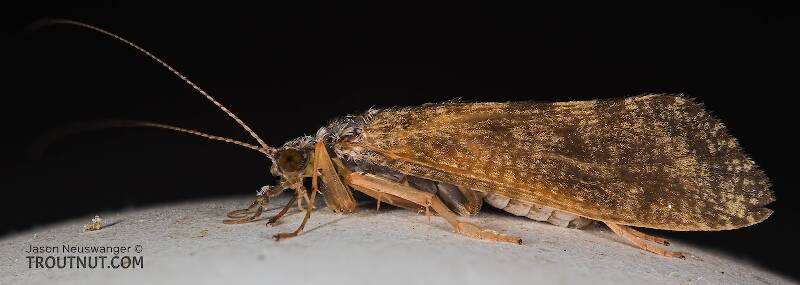
Blue-winged Olives
Baetis
Tiny Baetis mayflies are perhaps the most commonly encountered and imitated by anglers on all American trout streams due to their great abundance, widespread distribution, and trout-friendly emergence habits.


Caddisfly Species Ecclisomyia maculosa (Early Western Mottled Sedges)
Species Range
Hatching behavior
These flies emerge by crawling out onto shore.Larva & pupa biology
Current speed: Fast
Substrate: Rocks or gravel
Identification
Species ID from GBIFthe Global Biodiversity Information Facility
Source: The Nearctic Ecclisomyia species (Trichoptera: Limnephilidae)
Larval diagnosis. Of the four Nearctic Ecclisomyia, only Ecclisomyia maculosa lacks a prosternal sclerite, or small sclerotized area on the venter of the prothorax. The parietals have distinct muscle scars ventral and posterior of the eyes. Ecclisomyia maculosa lacks both anterodorsal and anteroventral gills on abdominal segment VII, but gills are present in the other Nearctic Ecclisomyia (Fig. 42). In addition, the Ecclisomyia maculosa larva may be separated from that of Ecclisomyia simulata by the lack of dorsoanterior gills on abdominal segment II, and the presence of these gills on the Ecclisomyia simulata larva. The Ecclisomyia maculosa larva is without lateral line gills, whereas the Ecclisomyia conspersa larva has 2 gills with 1 dorsolateral gill and 1 ventrolateral gill on each side of abdominal segments II – IV (Fig. 42).Source: The Nearctic Ecclisomyia species (Trichoptera: Limnephilidae)
Male diagnosis. Each inferior appendages has 2 large, black, stout spines arising from its base (Figs. 22 b, 23 b), separating Ecclisomyia maculosa from Ecclisomyia bilera, which lacks spines on the inferior appendages, and from Ecclisomyia conspersa which has a single black, stout spine on each inferior appendage (Fig. 10 a). The inferior appendages, viewed laterally, extend further caudad than the triangular inferior appendages of Ecclisomyia simulata. The shallow U- to V-shaped notch at the distal ends of the fused parameres of Ecclisomyia maculosa (Figs. 22 b, 23 b) distinguishes it from Ecclisomyia simulata which has a deep U- to V-shaped notch at the distal end of the fused parameres (Figs. 30 b, 31 b).
Source: The Nearctic Ecclisomyia species (Trichoptera: Limnephilidae)
Pupal diagnosis. The Ecclisomyia maculosa pupa may be separated from that of Ecclisomyia bilera by the absence of dorsal gills on abdominal segment VIIa and presence on Ecclisomyia bilera. The Ecclisomyia maculosa pupa may be separated from that of Ecclisomyia conspersa by the absence of lateral line gills; they are present on abdominal segments IIp – IVa of Ecclisomyia conspersa (Fig. 42). The apical processes of Ecclisomyia maculosa each have 2 stout, long, black setae at the apex, whereas those of Ecclisomyia conspersa each have 3 stout, long, black setae. The Ecclisomyia maculosa pupa may be separated from that of Ecclisomyia simulata by the absence of single filament dorsal gills on abdominal segment IIa and presence on Ecclisomyia simulata (Fig. 42).
Start a Discussion of Ecclisomyia maculosa
References
- LaFontaine, Gary. 1981. Caddisflies. The Lyons Press.
Caddisfly Species Ecclisomyia maculosa (Early Western Mottled Sedges)
Species Range
Common Names
Resources
- NatureServe
- Integrated Taxonomic Information System
- Global Biodiversity Information Facility
- Described by Banks (1907)

